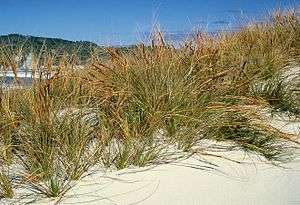Ficinia spiralis
| Pīngao | |
|---|---|
 | |
| Pīngao, Tauperikaka Point, West Coast, NZ | |
| Scientific classification | |
| Kingdom: | Plantae |
| (unranked): | Angiosperms |
| (unranked): | Monocots |
| (unranked): | Commelinids |
| Order: | Poales |
| Family: | Cyperaceae |
| Genus: | Ficinia |
| Species: | F. spiralis |
| Binomial name | |
| Ficinia spiralis (A.RIch) Muasya & de Lange[1] | |
| Synonyms[2] | |
| |
Ficinia spiralis (pīngao, pīkao, or golden sand sedge) is a coastal sedge endemic to New Zealand (including the Chatham Islands). Originally widespread, it has suffered severely from competition with introduced marram grass and animal grazing and now has only a patchy distribution.
Description
Pīngao is a stout, grass-like plant, 30–90 cm tall, from the sedge family, found on active sand dunes. It is found only in New Zealand and is easily distinguished from other dune species such as spinifex or marram grass. Seen from a distance, pīngao patches have a distinctive orange hue.
Most plants produce long, prostrate, tough rope-like stolons that creep along the sand surface until buried by shifting sand, leaving just the upper portion of leaves exposed. Some southern South Island populations produce dense tussock-like plants without extensive stolons.
Numerous tough, roughly textured leaves are borne in dense tufts on well-spaced, short, upright stems (tillers), along the length of stolons. The narrow leaves are 2–5 mm wide, with colour ranging from bright green when young through golden yellow to a deep orange on mature plants.[4]
Small, dark brown flowers appear in spring and are arranged spirally in tight clusters around the upper 10–30 cm of the upright stem (culm), interspersed with leaf-like bracts. The seeds are shiny, dark brown, egg-shaped, 3–5 mm long, and ripen and fall in early summer. Pīngao can also reproduce vegetatively with its stolons.
Taxonomy
Pīngao was first scientifically described by Achille Richard in 1832, and was given the name Isolepis spiralis.[5] In 1853 Sir Joseph Dalton Hooker placed Pīngao in the genus Desmoschoenus.[6] In 2010 A. M. Muasyaa and P. J. de Lange merged the genus Desmoschoenus into Ficinia after their research showed that the two were indistinguishable.[3]
In culture
One Māori name for pīngao (or pikao, in Ngai Tahu dialect) is ngā tukemata o Tāne, or "Tāne's eyebrows".
| “ | In the beginning of time there was a great conflict between Tane Mahuta, God of the Forest, and his brother Takaroa, God of the Sea. Takaroa was jealous of Tane Mahuta's success in separating Ranginui, the Sky Father from Papa-tu-a-nuku the Earth Mother. Tane Mahuta tried to end the warring between them and as a sign of peace plucked out his eyebrows and gave them to Takaroa. Takaroa's jealousy was so great that he could not find it in his heart to forgive Tane, and threw the eyebrows back onto the shore. There they grow today as Pikao, the Golden Sand Sedge, as the boundary between the forest and the sea, and in his continuing anger, Takaroa is still fighting against the domains of Tane Mahuta.[7] | ” |

Leaves from pīngao, which turn bright yellow as they dry, are used by Māori in traditional weaving, especially the construction of hats (pōtae), bags (kete), and mats (whāriki). It is also used to create decorative tukutuku panels in a wharenui.[8] The length, width, and strength of the leaves for weaving vary among pīngao populations growing in different areas. Leaves were also used by Māori for thatching.[6]
Conservation
|
|
Pīngao is an important sand-binding plant, but is out-competed by introduced sand binding species such as marram and Pinus radiata, and introduced weeds such as yellow tree lupins. Marram and pines create more stable dunes, so during colonisation large areas of pīngao were burnt. It is now restricted to scattered patches around coastal New Zealand, and is actively planted by community groups and the Department of Conservation when restoring native ecosystems.[4]
References
- ↑ "Ficinia spiralis (A.Rich.) Muasya & de Lange, 2010". www.NZOR.org.nz. Landcare Research. Archived from the original on 17 June 2016. Retrieved 3 June 2016.
- ↑ NZ Plant Conservation Network
- 1 2 Muasya, A. M.; de Lange, P. J. (March 2010). "Ficinia spiralis (Cyperaceae) a new genus and combination for Desmoschoenus spiralis". New Zealand Journal of Botany. 48 (1): 31–39. doi:10.1080/00288251003660703.
- 1 2 "Golden sand sedge/pīkao/pīngao". Department of Conservation Te Papa Atawahi. Retrieved 3 June 2016.
- ↑ Richard, Achille. "Essai d'une flore de la Nouvelee-Zélande". www.bibdigital.rjb.csic.es. Bibliotech Digital. Retrieved 3 June 2016.
- 1 2 Hooker, Joseph Dalton (1853). The botany of the Antarctic voyage of H.M. discovery ships Erebus and Terror in the Years 1839-1843 :under the command of Captain Sir James Clark Ross. London: Reeve Bros. p. 272. doi:10.5962/bhl.title.16029. Retrieved 3 June 2016.
- ↑ Herbert, A. and Oliphant, J. (1991). Pingao: The Golden Sand Sedge. Nga Puna Waihanga, New Zealand.
- ↑ Scheele, Sue; Sweetapple, Peter. "PĪNGAO". www.landcareresearch.co.nz. Landcare Research. Archived from the original on 15 April 2016. Retrieved 3 June 2016.
External links
| Wikimedia Commons has media related to Ficinia spiralis. |
| Wikispecies has information related to: Ficinia spiralis |
- Pīngao discussed on RNZ Critter of the Week, 3 June 2016
- Objects made from pingao in the collection of the Museum of New Zealand Te Papa Tongarewa